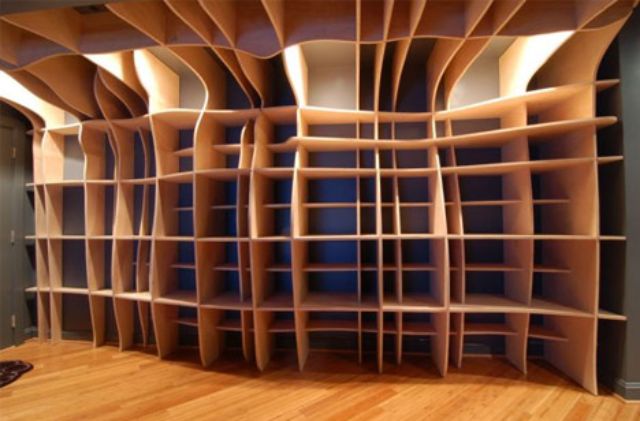Custom Built-In Wood Wall Shelves

In a small condo or apartment it can be difficult to plan for or sacrifice space for storage. Still, when the bookcase can look this beautiful and become an integral part of an incredible interior hallway design … well, it becomes a much easier decision to make.

In an age of digital fabrication technologies, creating curved cuts is easier than ever – especially in already-flat materials like these plywood horizontal shelves and vertical supports. DBD design + build studio had a relatively simple task: pre-cut the pieces and then fit them together as a three-dimensional puzzle on site.

A lack of shelving space for books and collected odds and ends coupled with the desire for an artistic solution let to this wrap-around, built-in solution. The unit as a whole is built up along the wall but also made to wrap across the ceiling and create a transitional envelope of engaging and undulating space between the entryway and main living spaces of the home.
The designers primarily focus on public furniture. Here’s some more info about their work:
“DBD Studio has resulted from cross-pollination of design backgrounds, coming together to create architectural street furniture product design DBD’s competence embraces the urban landscape with street benches as well as planters and litter bins, bollards and street signs.
“DBD produce designs for standard and custom made street furniture with a heavy focus on timber products and related technology that are used to to produce optimal quality, environmentally friendly furniture.”
“The term street furniture has evolved into a collective noun used to describe any upright structure designed to provide pedestrian amenity in streetscape environments. And the vast majority of street furniture is located on the sidewalk. In the last 3 years, an increasing array of different types of street furniture has evolved in line with the pedestrian and traffic behaviour trends in modern towns and cities. An ever increasing ‘space’ demand on our roads has precipitated a concurrent rise in safety, environmental and traffic control regulations Furthermore, the quantities of street furniture on our streets has similarly increased to provide improved seating, shopping booths, newsstands, bus stops and information signs. Urban planners have become more and more conscious of this street furniture proliferation and have and are still acting to overcome and avoid problems associated with location and design of street furniture and its impact on visually or mobility impaired citizens, wheelchair users and everyday pedestrians.”




